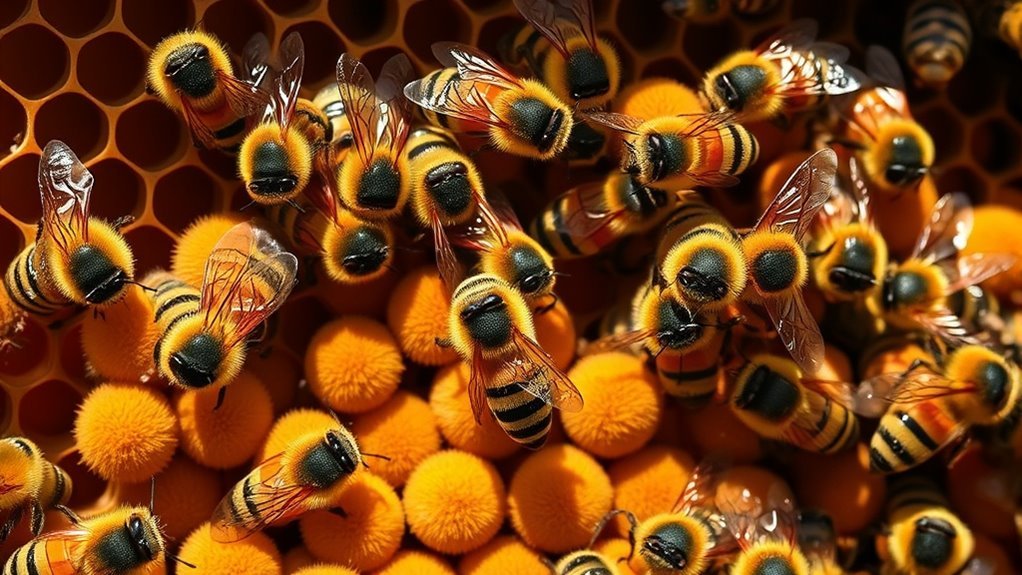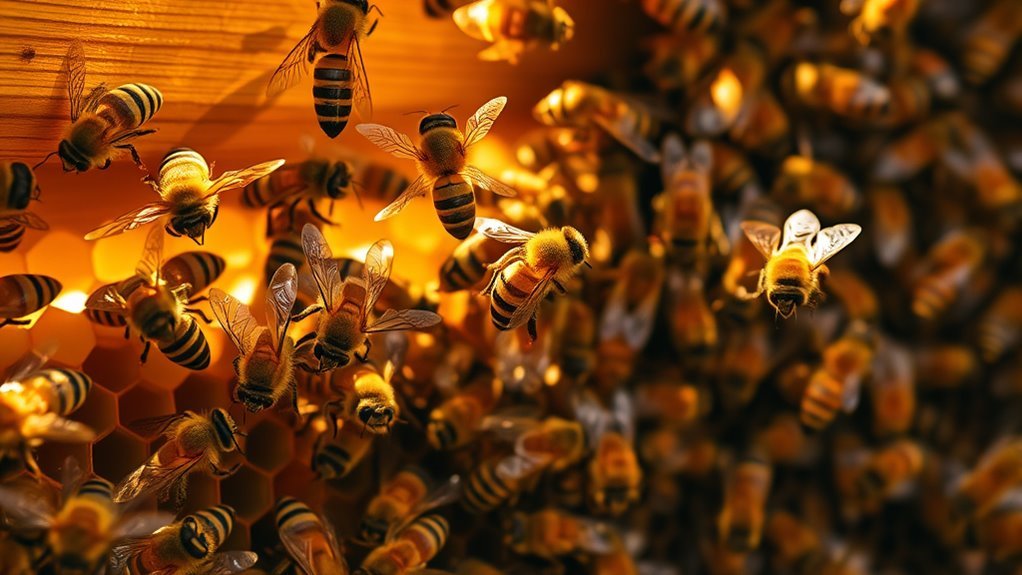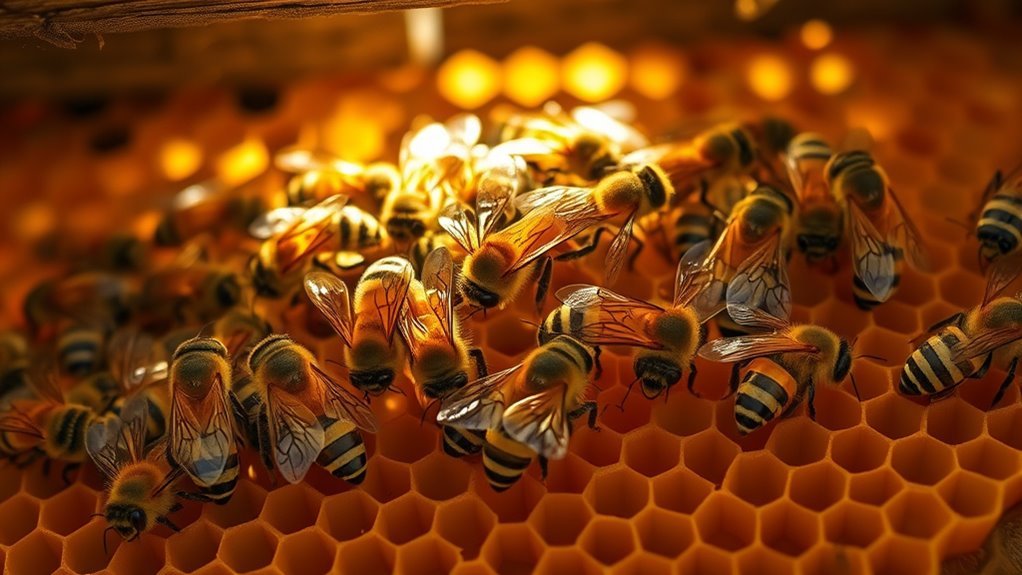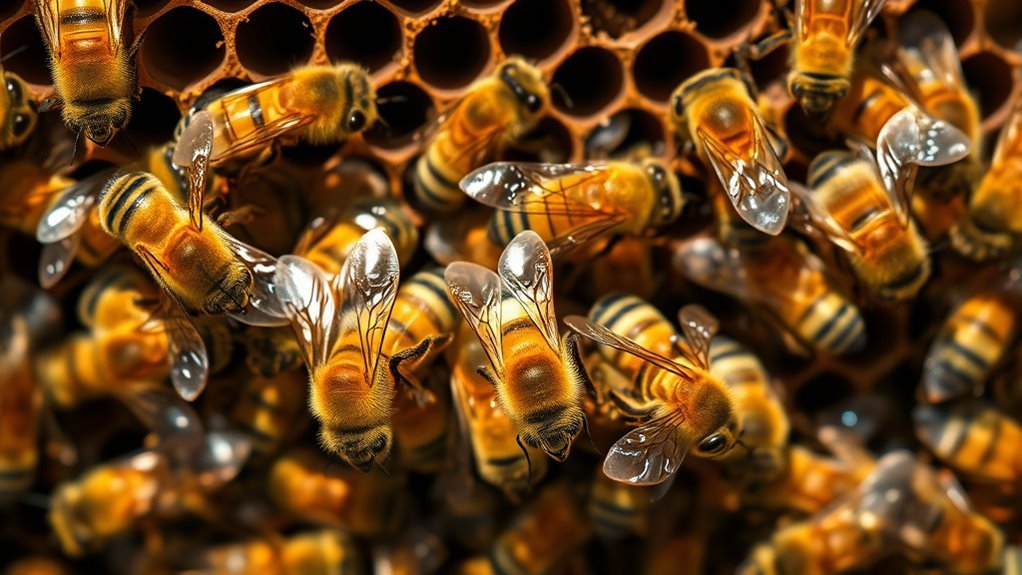Drone honey bees primarily exist to mate with virgin queens, enabling genetic diversity essential for colony resilience and survival. You’ll notice they differ markedly from workers—they’re larger, lack stingers, and don’t forage or defend the hive. Their numbers peak seasonally when mating opportunities arise and decline sharply afterward as colonies regulate resources efficiently. Understanding this reproductive role sheds light on the hive’s complex social structure and how drones influence overall colony health and function.
The Physical Characteristics of Drone Honey Bees

Although drone honey bees share the general anatomy of worker bees, their physical characteristics are distinct and specialized for their reproductive role. When examining drone morphology, you’ll notice they are larger and more robust than workers, with a bulkier thorax and abdomen. Their eyes are particularly large and meet at the top of the head, enhancing visual acuity for detecting queens during mating flights. Drone anatomy lacks the stinger and pollen-carrying structures present in workers, reflecting their sole function in reproduction. Additionally, their wings are proportionally smaller relative to body size, optimized for flight rather than labor. Understanding these specific traits helps you appreciate the evolutionary adaptations that enable drones to fulfill their unique purpose within the hive’s social structure.
The Development and Lifecycle of Drones

The specialized physical traits of drone honey bees are closely linked to their distinct development and lifecycle. Drone development begins when unfertilized eggs are laid in larger cells, leading to a haploid genome. The drone lifecycle spans approximately 24 days, including egg, larva, pupa, and adult stages. Unlike workers, drones do not participate in hive maintenance, focusing instead on reproductive roles.
| Stage | Duration (days) | Key Characteristics |
|---|---|---|
| Egg | 3 | Unfertilized, haploid |
| Larva | 6 | Fed by workers, rapid growth |
| Pupa | 14 | Metamorphosis, development of wings |
| Adult | 1+ | Mating flights, no hive labor |
Understanding drone development and drone lifecycle reveals their essential reproductive purpose in the hive’s freedom and genetic diversity.
How Drones Differ From Worker Bees

Physical and behavioral differences set drones apart from worker bees in several key ways. Understanding these distinctions helps you appreciate their unique drone roles and worker differences within the hive’s complex society.
- Anatomy: Drones are larger, with bigger eyes and no stingers, unlike smaller, stinger-equipped workers.
- Function: Workers perform foraging, nursing, and hive maintenance; drones primarily exist for reproduction-related roles.
- Lifespan: Drones live shorter lives, typically expelled after mating season, while workers have longer, more varied duties.
- Genetics: Drones develop from unfertilized eggs (haploid), contrasting with diploid workers from fertilized eggs.
Recognizing these differences lets you see how the hive balances freedom through specialized roles, with drones and workers each fulfilling essential, distinct purposes.
The Mating Role of Drone Honey Bees
You’ll find that drone honey bees exhibit specific mating behaviors, including timing their flights to coincide with queen activity. Their flight patterns are highly targeted, often involving congregating at drone congregation areas to increase mating success. These behaviors directly influence the genetic diversity and health of the hive through their contribution to the queen’s offspring.
Drone Mating Behavior
Several key behaviors characterize drone honey bees during their mating period, which is crucial for the reproductive success of the colony. You’ll find that their mating strategies are finely tuned by evolution, focusing on maximizing genetic diversity through selective drone selection. As you observe, keep in mind these critical aspects:
- Drones congregate in specific mating areas, known as drone congregation areas (DCAs).
- They compete intensely for access to virgin queens, relying on rapid flight and precise timing.
- Only the strongest drones succeed, ensuring robust genetic contribution.
- Mating occurs midair, after which drones die, highlighting the ultimate sacrifice for colony propagation.
Understanding these behaviors reveals the complexity and freedom inherent in drone mating, underscoring their essential, though brief, role within the hive’s life cycle.
Drone Flight Patterns
The behaviors exhibited during drone mating are closely linked to their specific flight patterns, which guide them to drone congregation areas and optimize their chances of encountering a virgin queen. You’ll notice that drones employ sophisticated drone navigation strategies, relying on environmental cues like the sun’s position and landscape features to orient themselves. This precise navigation enhances drone flight efficiency, minimizing energy expenditure during extended flights. Typically, drones depart the hive in the afternoon, converging in established congregation zones where mating occurs. Their flight patterns are characterized by looping and hovering, allowing them to detect queen pheromones accurately. Understanding these flight behaviors reveals how drones maximize reproductive success while conserving energy, reinforcing their essential role in sustaining hive genetic diversity through targeted, efficient mating flights.
Genetic Contribution Impact
Although drone honey bees do not participate in typical hive tasks, their genetic contribution through mating is indispensable for the colony’s survival and evolution. By mating with a queen during her nuptial flights, drones directly influence the colony’s genetic diversity, which is essential for resilience against disease and environmental changes. Their reproductive success guarantees healthy, adaptable offspring, safeguarding the hive’s future.
Consider these key impacts of drone mating:
- Enhances genetic diversity within the hive.
- Promotes colony adaptability and health.
- Increases chances of reproductive success for the queen.
- Supports the evolutionary fitness of future generations.
Understanding this role reveals how drones, though limited in hive duties, are fundamental contributors to the freedom and sustainability of bee populations.
Drone Bees and Hive Genetics
Because drone bees contribute solely to the genetic diversity of a hive through their haploid sperm, understanding their genetic role is fundamental for grasping colony health and resilience. When you examine drone genetics, you see that each drone develops from an unfertilized egg, carrying only one set of chromosomes. This haploid state means drones provide unique genetic material to the queen during mating, increasing the hive’s genetic diversity. Greater genetic diversity equips the colony with a broader range of traits, enhancing adaptability and survival under environmental pressures. By recognizing the specific role drone genetics play, you appreciate how drones act as essential vectors for genetic variation, ensuring the continuation of diverse and robust honey bee populations important for ecological balance and freedom in natural processes.
The Impact of Drones on Hive Health
When you consider hive health, drones play a crucial but often overlooked role beyond genetics. Their presence enhances drone diversity, which directly influences the hive ecosystem’s resilience. Drones contribute to genetic variability, supporting colony adaptability and disease resistance. Additionally, they influence social dynamics, affecting worker bee behavior and hive cohesion. You should recognize these key impacts:
- Increased drone diversity strengthens colony immunity against pathogens.
- Drones facilitate genetic exchange, promoting population health.
- Their activity regulates worker bee roles, maintaining hive function.
- Drone presence signals a balanced, thriving hive ecosystem.
Understanding these factors lets you appreciate how drones sustain hive importance. Their impact extends beyond reproduction, playing an integral role in maintaining the freedom and robustness of your colony’s community.
Seasonal Patterns of Drone Activity
As you observe hive activity throughout the year, you’ll notice that drone presence fluctuates markedly with the seasons. Seasonal variations dictate the number of drones within the colony, with populations peaking in late spring and summer when mating opportunities arise. Environmental influences such as temperature, forage availability, and daylight length critically affect drone development and activity. Cooler temperatures and reduced resources during fall and winter lead to a significant decline in drone numbers as the colony conserves energy. These patterns guarantee drones are present when conditions favor mating flights, maximizing reproductive success. Understanding these seasonal shifts provides insight into the colony’s reproductive strategies and highlights how environmental factors play a pivotal role in regulating drone activity throughout the year.
The Colony’s Regulation of Drone Population
You’ll find that the colony actively regulates drone numbers to balance reproductive needs with resource availability. Seasonal fluctuations impact how many drones are supported, ensuring the hive allocates energy efficiently. Understanding these mechanisms reveals how the hive maintains ideal function throughout the year.
Drone Population Control
Although drones play an essential role in reproduction, the colony carefully regulates their population to balance resource allocation and hive efficiency. You’ll notice the hive employs drone suppression tactics to maintain this balance, ensuring resources aren’t wasted on excess drones. This strategic resource management allows the colony to thrive without compromising freedom in the hive’s function. Here’s how the population control works:
- Worker bees monitor drone numbers, removing surplus drones when necessary.
- Limited drone brood cells restrict drone reproduction capacity.
- Food supply directly influences drone rearing decisions, preventing overpopulation.
- The queen’s egg-laying adjusts to hive conditions, aligning drone numbers with environmental needs.
Seasonal Drone Fluctuations
When environmental conditions shift throughout the year, the colony adjusts its drone population accordingly to optimize survival and reproductive success. You’ll notice drone emergence peaks during spring and early summer, reflecting the hive’s preparation for mating flights. As resources dwindle in late summer and fall, the hive reduces drone numbers to conserve energy.
| Season | Drone Population Status |
|---|---|
| Spring | Increasing |
| Summer | Peak abundance |
| Fall/Winter | Declining |
This seasonal abundance pattern guarantees drones are present when mating opportunities arise but minimized when they no longer serve a reproductive purpose. By regulating drone numbers, the colony balances reproductive needs with resource availability, permitting you a glimpse into the sophisticated strategy underpinning hive population dynamics.
Hive Resource Allocation
Understanding how drone populations fluctuate with the seasons sets the stage for examining how the colony manages its internal resources to regulate these numbers. Hive resource allocation is critical, as drones consume substantial energy without contributing to foraging or defense. The colony carefully balances resource distribution to optimize survival and reproductive success. You’ll notice that:
- In early spring, resource abundance allows increased drone rearing.
- During resource scarcity, drone production sharply decreases.
- Worker bees actively remove excess drone brood to conserve resources.
- Resource distribution prioritizes worker and queen sustenance over drones in lean periods.

